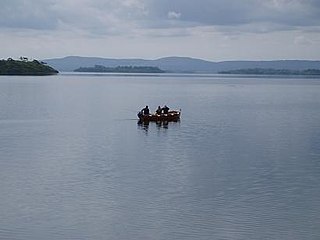
Lough Corrib is a lake in the west of Ireland. The River Corrib or Galway River connects the lake to the sea at Galway. It is the largest lake within the Republic of Ireland and the second largest on the island of Ireland. It covers 176 km² and lies mostly in County Galway with a small area of its northeast corner in County Mayo.

The stone circle at Castlerigg is situated near Keswick in Cumbria, North West England. One of around 1,300 stone circles in the British Isles and Brittany, it was constructed as a part of a megalithic tradition that lasted from 3,300 to 900 BC, during the Late Neolithic and Early Bronze Ages.

Aughagower or Aghagower is a small village in rural County Mayo in western Ireland. It is located about 6 km from Westport. Aughagower has around 40 houses, 1 pub and a shop, with a clear view of Croagh Patrick from Reek View. It also forms the centre of a parish of the same name which covers an area of 86.1 square miles. The village is known for its links to Saint Patrick and Tóchar Phádraig, the pilgrimage route from Ballintubber Abbey to Croagh Patrick.
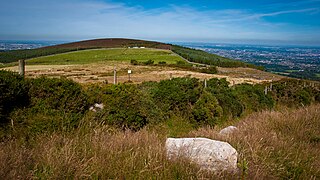
Kilmashogue or Kilmashoge is a mountain in Dún Laoghaire–Rathdown county in Ireland. It is 408 metres high and forms part of the group of hills in the Dublin Mountains which comprises Two Rock, Three Rock, Kilmashogue and Tibradden Mountains. The forest plantation on its northern slope, which is composed mainly of Sitka spruce, Scots pine and beech, is a habitat for Sika deer, hares, rabbits and foxes. A number of prehistoric monuments can be found on the slopes of the mountain.

Carrigagulla is a megalithic complex 2.9 km north-east of Ballinagree, County Cork, Ireland.

Grange stone circle is a stone circle in County Limerick, Ireland. It is located 300m west of Lough Gur, 4 km north of Bruff. The Limerick-Kilmallock road is nearby.
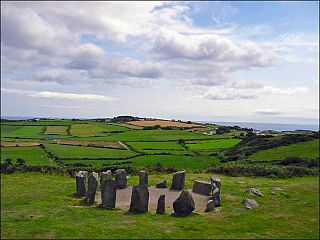
Drombeg stone circle, is a small (9 m axial stone circle located 2.4 km east of Glandore, County Cork, Ireland. The structure consists of 17 tightly packed stones. As an axial or "Cork–Kerry" stone circle, it contains two taller entrance stones placed opposite a recumbent axial stone. Its axis is orientated south west towards the setting sun.

The Uragh Stone Circle is a stone circle near Gleninchaquin Park, Tuosist, County Kerry, Ireland.

The River Cong is a short river of moderate flow in Ireland, primarily in County Mayo but also touching County Galway.

The Cross of Cong is an early 12th-century Irish Christian ornamented cusped processional cross, which was, as an inscription says, made for Tairrdelbach Ua Conchobair, King of Connacht and High King of Ireland to donate to the Cathedral church of the period that was located at Tuam, County Galway, Ireland. The cross was subsequently moved to Cong Abbey at Cong, County Mayo, from which it takes its name. It was designed to be placed on top of a staff and is also a reliquary, designed to hold a purported piece of the True Cross. This gave it additional importance as an object of reverence and was undoubtedly the reason for the object's elaborate beauty.
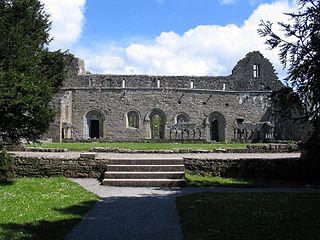
Cong Abbey also known as the Royal Abbey of Cong, is a historic site located at Cong Mayo, in Ireland's province of Connacht. The ruins of the former Augustinian abbey mostly date to the 13th century and have been described as featuring some of finest examples of medieval ecclesiastical architecture in Ireland.
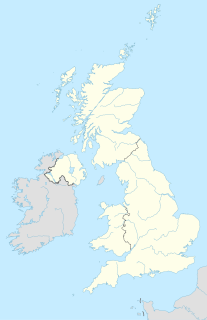
Aghanaglack or Aghnaglack, is a townland in County Fermanagh, Northern Ireland. It is situated in the civil parish of Boho, as well as Fermanagh and Omagh district.

Goodaver, Goodaver stone circle or Goodaver circle is a stone circle located in the parish of Altarnun, near Bolventor on Bodmin Moor in Cornwall, UK.
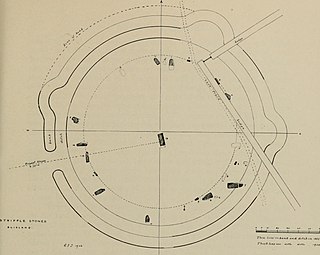
The Stripple stones is a henge and stone circle located on the south slope of Hawk's Tor, Blisland, 10 kilometres (6.2 mi) north northeast of Bodmin on Bodmin Moor in Cornwall, England, UK.
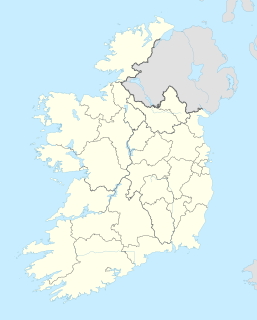
Lankill Standing Stone is a standing stone and National Monument located in County Mayo, Ireland.

Kelly's Cave is a limestone solutional cave and National Monument in County Mayo, Ireland.

Ballymacgibbon Cairn is a cairn and National Monument located in County Mayo, Ireland.

Eochy's Cairn is a cairn and National Monument located in County Mayo, Ireland.

Drumaleague Lough is a very small freshwater in northwest Ireland. The ecology of Drumaleague Lough, and other Leitrim waterways, remain threatened by zebra mussel and other invasive species.

Maughanasilly Stone Row is a stone row and National Monument located in County Cork, Ireland.

















